In Japan, tsukemono or pickles are used as hashi-yasume, literally "chopstick resters", side dishes that have a totally different texture and flavor. So for instance if you had some grilled meat with a sweet-savory sauce as the main course, you might have some simple, crunchy pickled cucumber slices to go with it.
This week I'll be posting some quick Japanese vegetable pickle recipes. Japanese pickles can be very loosely divided into three kinds: the kind that take some time to 'ripen', but then last indefinitely, rather like Western style pickles; the kind that is ready in a few days, but which require a pickling bed that takes time to make and to maintain; and finally, the quick and easy kind that can be made and eaten within a day. The last two kinds do not keep well - just like fresh vegetables, they must be eaten within a short time.
Quick pickles, called sokusekizuke (instant pickles) or ichiya-zuke (overnight pickles) depending on how long they take to come to full flavor, are very easy to make as their names suggest. They are a great way to prepare vegetables without having to add any additional fat, though a few recipes do call for some oil.
Filed under:
japanese lighter preserves and pickles vegetables vegan salad tsukemono
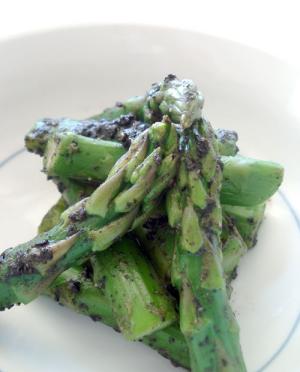
We're starting to see asparagus at reasonable prices again in the stores, which I'm really happy about. The ones available now come from California and Mexico, so they aren't very food-miles-correct, but I still can't resist buying a bunch or two. In a few weeks we'll start seeing asparagus from a a bit closer places like Spain and France, not to mention fat white asparagus from Germany.
This is aspagarus with a ground sesame sauce, which would be called aemono (as explained in the broccoli ae recipe) if made with white sesame seeds, but since this version is made with black sesame seeds it's called gomayogoshi, or "dirtied with sesame". I don't think it looks dirty - I really like the contrast of the bright green asparagus with the black sesame sauce. You can, of course, use regular white (brown) sesame seeds instead, in which case it would be called asparagasu no goma ae. The sweet nutty sauce compliments the asparagus quite well.
I've included step by step instructions for grinding sesame seeds in a suribachi. You can grind up the sesame seeds in a plain mortar and pestle instead. You may be able to buy pre-ground sesame (surigoma), though that isn't nearly as fragrant as freshly ground sesame.
It makes a great side dish, as well as being great for your bento box.
Filed under:
japanese lighter vegetables vegetarian bento vegan gluten-free
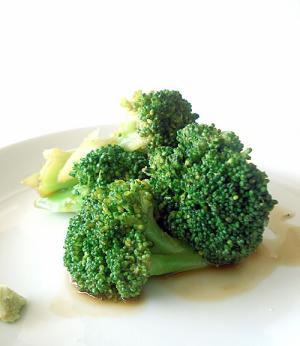
All hail the mighty broccoli. While it's always available in the produce section, it's one of the few fresh vegetables that haven't been shipped halfway around the world to reach people who live in many parts of the northern hemisphere during the colder months. In the spring we even get very locally grown broccoli and its relatives like romanesco.
Broccoli can be rather boring if it's just served steamed, boiled or, god forbid , raw. (I'm sorry, I don't really get raw broccoli. Raw cauliflower yes, but not raw broccoli.) A way to perk up broccoli without relying on those yummy yet caloric additions like mayonnaise, cheese sauce or garlic-and-olive-oil, is to make aemono or ohitashi with them. Ohitashi is basically vegetables that have been steamed or blanched/boiled served with a sauce that contains soy sauce, often but not always a little dashi stock, and sometimes a bit of sake or mirin and sugar. Aemono uses a similar sauce, with added ingredients like ground up sesame seeds. In this recipe, the sauce contains wasabi, so it's aemono.
As long as you have all the ingredients on hand it's very quick to make, and very tasty. The sinus-clearing qualities of the wasabi are softened by the other ingredients in the sauce, while still giving the broccoli a nice, bright flavor.
It makes a great side dish as part of a Japanese meal, or even a salad. It's also a very nice bento item (you may want to contain the sauce in a paper cup or its own container).
Filed under:
japanese lighter vegetables vegetarian quickcook bento vegan under10 gluten-free

One of the things I like to do with tofu that didn't quite come together is to turn it into a pudding. Now I do not pretend to you that this tastes like a proper pudding or mousse made with cream and such, and if anyone tries to convince you that a tofu based dish like this is 'just as good/rich as the real thing' they are either lying or have no taste buds. It's different, but still good. It's a lightly sweet, cool and creamy dish that will quiet a sudden urge for Something Sweet. Since it's quite healthy it will leave you feeling righteous, thus the name.
It's also a dish that you can whip up in no time at all. I realize that many of the recipes here take a lot of time, effort or both, and I'm going to try to rectify that. Look for recipes with the quickcook or under 10 tags.
Filed under:
dessert lighter vegetarian sweet tofu quickcook vegan under10
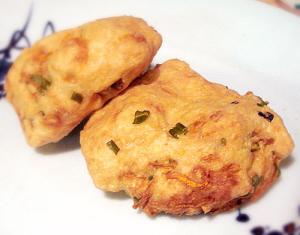
Ganmodoki or hiryouzu are small deep-fried fritters made of tofu and various ingredients. They are either eaten as-is or cooked in a broth. They are used as a meat substitute in sho-jin ryouri, vegan buddhist cuisine. (They are supposed to taste like deer meat, though they don't at all.)
Ganmodoki is sold pre-made in supermarkets, in the refrigerated section, and is usually eaten in an oden, a sort of stew of various fishcakes and such. But store bought ganmodoki, which has the texture of a sponge, is nothing like freshly made ganmodoki. Once you have tried a freshly made, piping hot ganmodoki, it's just about impossible to think about saving them for later.
I have tried baking these or pan-frying them instead of deep frying, but the texture just isn't the same. It just demands that crispy-crunchy delicate crust given by the oil. If it's any consolation, they don't really absorb much oil.
Yamaimo
One ingredient that gets omitted in a lot of English-language ganmodoki recipes is yamaimo, often called Japanese Yam. It is a root vegetable that is tremendously viscous in texture, sort of like the inside of an okra. It gives a sort of bouncy yet light texture to whatever it's added to. You can find fresh yamaimo in the produce section of Japanese grocery stores, cut into sections and wrapped in plastic. It's quite expensive but you usually only need a little bit of it, and keeps quite well in the refrigerator well as long as you re-wrap it in plastic to prevent the ends from oxidizing. The cut ends were traditionally dipped in some fine sawdust for storage. You may also be able to find yamaimo powder (Note to European readers - Japan Centre in the UK carries this). Regular grated potato can be used as a substitute if you can't find yamaimo - it gives a different texture but still adds that sort of bouncy quality. It has to be grated to a fine pulp, not into shreds.
The other ingredients
All the additions to ganmodoki are there to add texture, umami, or both. You can vary it quite a bit by adding things that capture your imagination. You can even turn it into a more Western-flavored item by adding things like green peas, finely chopped and cooked mushrooms, and so on, and eating them with a bit of Worcestershire sauce or even ketchup. However, to my mind the traditional Japanese flavor is the best.
Filed under:
japanese vegetarian tofu vegan
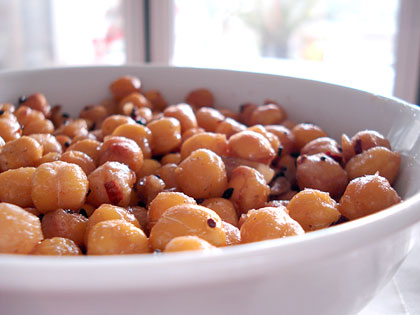
When I'm really into something, whether it's trying to debug some code or work out a design that won't gel, I forget about everything else, including eating. Then, hours later I raise my head out of the mire and I'm starving and ready to eat everything in sight - usually stuff like potato chips and cookies.
Filed under:
snack legumes vegan
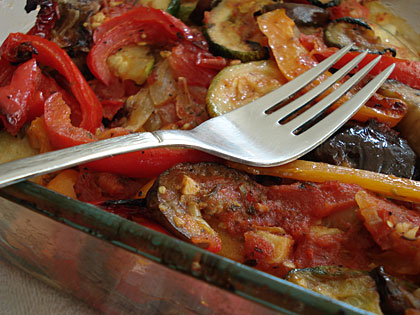
Although ratatouille seems synonymous with summer, perhaps because it comes from sunny Provence, I think it's really a dish to make right now, in early fall. This is when the essential ingredients - eggplants (aubergines), fresh tomatoes, zucchini (courgettes), sweet onions, and peppers - are all at their peak. You can get all of those things year-round nowadays of course, but vegetables in season are always just a bit sweeter.
Filed under:
weekend project french favorites vegan
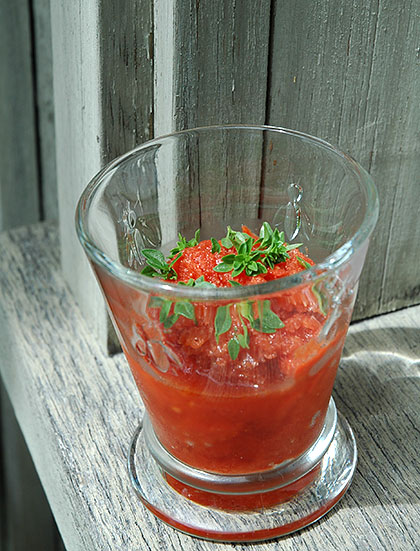
Is it still steaming hot where you are? It has finally cooled down a bit here - yesterday it rained all day, and right now it's comfortably cool. We may yet have a heatwave though, and I'm still craving icy things to eat.
Filed under:
vegetables summer vegan

As I have mentioned before, The Hungry Tiger is one of my favorite food blogs. Ms. redfox, the owner, recently posted about a delicious looking lentil snack called kibbeh. Lentils are one of my favorite things, so I just had to try it.
Filed under:
snack legumes vegan
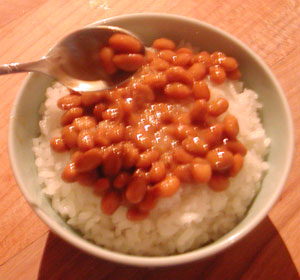
Japanese people like to consume soy beans in many forms. The most well known soy bean product outside of the country is tofu, and edamame (green soy beans) is gaining in popularity too. There is one Japanese soy bean product that probably will never become very popular in other countries though, and that's natto.
Filed under:
japanese ingredients natto legumes vegetarian vegan
Pages